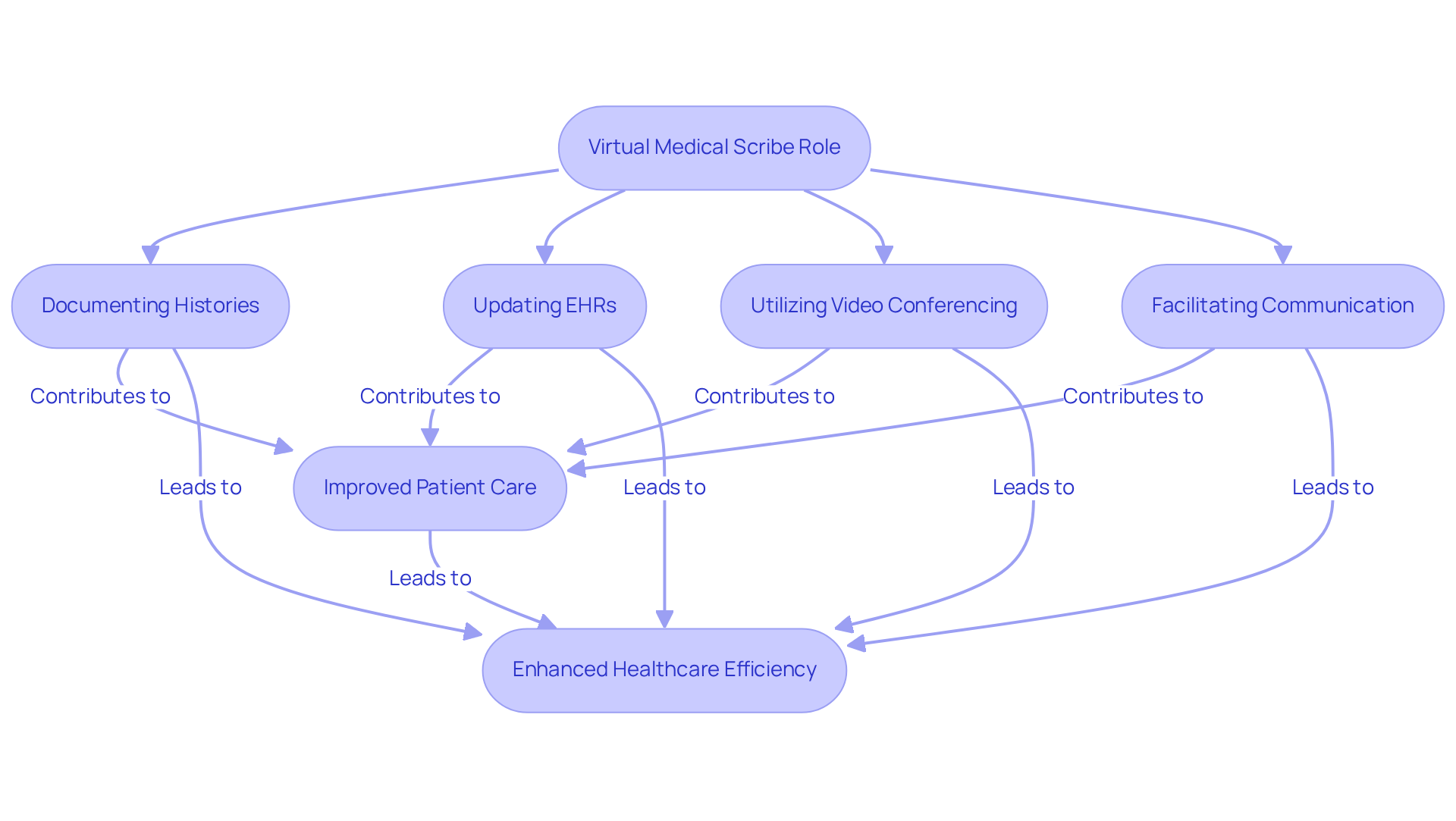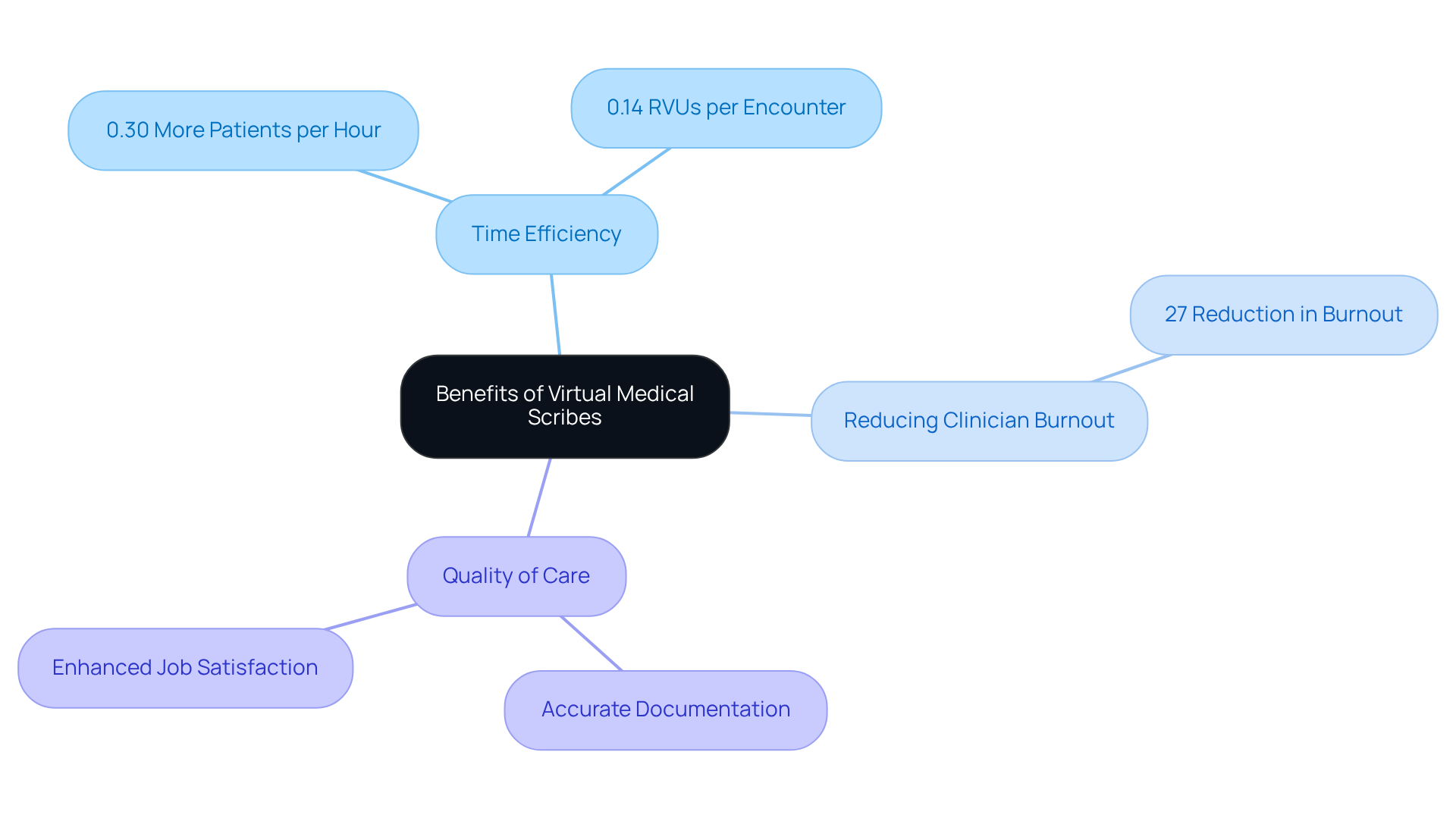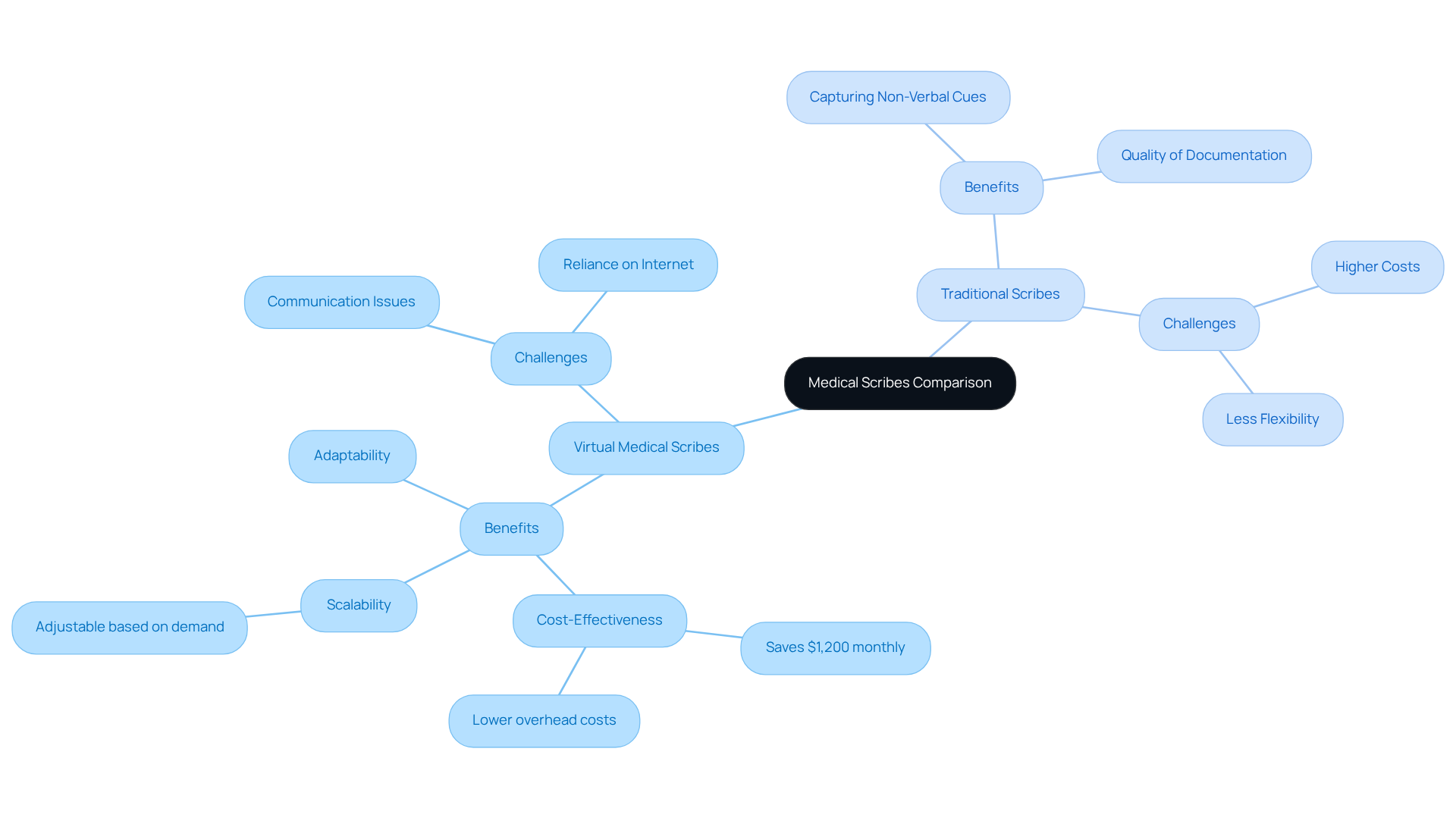Overview
Healthcare providers often face overwhelming emotional challenges, juggling patient care with administrative tasks that can detract from their focus. A virtual medical scribe steps in to support these dedicated professionals by documenting patient interactions remotely. This not only alleviates the administrative burdens they carry but also allows them to devote more time to what truly matters—their patients.
Imagine the relief of having someone else manage the documentation, ensuring accurate and real-time updates to electronic health records (EHRs). This role enhances the quality and efficiency of documentation, as evidenced by studies showing significant reductions in EHR time per appointment. With this support, clinicians can provide more compassionate care, fostering stronger connections with their patients.
If you’re a healthcare provider feeling the weight of these responsibilities, consider how a virtual medical scribe could transform your practice. By embracing this innovative solution, you can reclaim precious time and enhance the overall patient experience. Let’s explore how this change can positively impact your daily routine and the care you provide.
Introduction
The landscape of healthcare is evolving, and with it comes a profound emotional challenge for providers. Technology is stepping in to play a pivotal role in enhancing patient care and operational efficiency. In this context, virtual medical scribes have emerged as indispensable allies, offering a seamless way to manage documentation and administrative tasks from a distance.
As these digital assistants take on the vital responsibility of recording patient interactions in real-time, one must reflect: how do they truly transform the day-to-day operations of medical practices? By exploring their roles and benefits, we can uncover the impact on clinician workload and the potential for improved patient outcomes in an increasingly demanding environment.
Imagine a world where healthcare providers can focus more on patient care rather than being bogged down by paperwork. This transformation is not just a dream; it is becoming a reality with the help of virtual medical scribes. They alleviate the administrative burden, allowing clinicians to dedicate more time to their patients.
In an era where every moment counts, these digital allies are not just tools; they are partners in the journey toward better healthcare. Let’s delve deeper into how they can support your practice and enhance the care you provide.
Define Virtual Medical Scribe: Role and Responsibilities
An online medical assistant is a compassionate expert who supports healthcare providers by recording client interactions from a distance, which raises the question of what does a virtual medical scribe do. Their primary responsibilities include documenting individual histories, symptoms, and treatment plans during consultations, which leads to an understanding of what does a virtual medical scribe do to ensure that electronic health records (EHRs) are updated in real-time. Unlike traditional recorders who are physically present in the examination room, remote assistants utilize secure video conferencing or audio technology to capture and transcribe information. This enables clinicians to focus entirely on patient care without the distraction of recording. This role is essential for and facilitating seamless communication between healthcare providers and patients.
The incorporation of digital medical note-takers significantly enhances record accuracy. For instance, a study at Brigham and Women’s Hospital revealed that employing digital assistants led to a remarkable 16% decrease in overall EHR time per appointment, reducing it from 35.1 minutes to 29.5 minutes. This efficiency not only simplifies the record-keeping process but also allows healthcare providers to engage more meaningfully with their patients, fostering improved communication and satisfaction.
Healthcare professionals recognize what does a virtual medical scribe do to alleviate the administrative burden. As industry specialists note, these writers manage records and administrative tasks, allowing physicians to focus on their interactions with clients. This shift not only boosts job satisfaction among providers but also enhances the overall quality of care delivered to individuals. By ensuring precise and timely documentation, virtual medical assistants exemplify what does a virtual medical scribe do in modern healthcare delivery.
How much more could you achieve if your administrative tasks were streamlined? Embracing the support of online medical assistants can transform your practice, allowing you to dedicate more time to what truly matters—your patients. Consider exploring how these compassionate professionals can make a difference in your healthcare delivery.

Explain How Virtual Medical Scribes Operate in Healthcare
Virtual medical assistants play a crucial role in enhancing healthcare provision, allowing for consultations from a distance through secure video calls or audio streams. They listen attentively to the conversations between individuals and healthcare providers, capturing vital information in real-time. This process is made possible by specialized software that integrates seamlessly with Electronic Health Record (EHR) systems, enabling staff to input data directly into patient records as consultations unfold. This timely record-keeping ensures that all relevant details are accurately captured, significantly .
As we look ahead to 2025, the technology utilized by digital writers has evolved to include advanced features such as Natural Language Processing and real-time transcription capabilities, which simplify the record-keeping process. A study involving 144 doctors revealed that using digital assistants led to a 16% reduction in total EHR time per appointment, allowing providers to focus more on patient care rather than administrative tasks. Isn't it heartening to see technology making such a positive impact?
Moreover, case studies highlight the successful integration of digital note-takers with EHR systems, showcasing their ability to enhance documentation accuracy and efficiency. For instance, primary care experts experienced a decrease in overall EHR duration from 39.8 minutes to 36.6 minutes per appointment, illustrating the beneficial influence of digital assistants on workflow efficiency. By alleviating the administrative burden, digital assistants empower healthcare professionals to dedicate more time to meaningful interactions with individuals, ultimately elevating the overall standard of care.
In a field where every moment counts, these advancements not only streamline processes but also foster a more compassionate healthcare experience. How might these tools transform your practice? Embracing this technology could be a significant step toward enhancing patient care and alleviating the pressures faced by healthcare providers.

Discuss Benefits of Virtual Medical Scribes for Healthcare Providers
The integration of virtual medical assistants into healthcare practices raises the question of what does a virtual medical scribe do, as it brings forth a range of meaningful benefits for providers. Have you ever felt overwhelmed by the time spent on documentation? These record keepers significantly reduce that burden, allowing healthcare providers to focus more on the essential interactions with those in their care. This newfound time efficiency not only increases the number of clients seen but also enhances the quality of care provided. Research indicates that note-takers can elevate the patient volume attended to each hour by an average of 0.30 patients, while also improving relative value units (RVUs) per encounter by 0.14.
Moreover, to understand what does a virtual medical scribe do, it is essential to recognize that virtual assistants play a vital role in addressing clinician burnout, a common and distressing issue stemming from excessive administrative tasks. By managing records and other clerical duties, they help alleviate stress levels among healthcare professionals. Studies have shown a remarkable 27% reduction in burnout among primary care doctors who have welcomed assistants into their teams, underscoring the positive impact on clinician well-being.
In addition to these advantages, knowing what a virtual medical scribe does ensures accurate and timely documentation, which not only boosts compliance with regulatory standards but also enhances the overall quality of medical records. This meticulous attention to detail fosters improved outcomes for individuals while creating a more rewarding work environment for healthcare professionals. Ultimately, these benefits lead to , as clinicians can devote more time to their primary mission: delivering exceptional care to individuals.

Compare Virtual Medical Scribes to Traditional Scribes
In the demanding world of healthcare, providers often face overwhelming administrative burdens that can detract from their primary focus on patient care, which raises the question of what does a virtual medical scribe do. Virtual medical assistants and both play crucial roles in documenting client interactions, yet their operational frameworks differ significantly. Traditional recorders are physically present in the examination room, allowing them to capture non-verbal cues and engage directly with both the patient and the provider. This closeness can enhance documentation quality by providing context that online notetakers might miss.
However, the unique benefits of online notetakers cannot be overlooked. They offer adaptability, affordability, and the ability to expand services based on practice requirements. Imagine being able to work from any location—this flexibility is particularly advantageous for practices with multiple sites or those needing after-hours support. Cost-effectiveness is another vital aspect; digital medical assistants typically incur lower overhead expenses compared to their conventional counterparts, who require salaries, benefits, and workspace. For practices employing digital assistants, savings can amount to roughly $1,200 monthly compared to hiring onsite personnel, making them an appealing option for those looking to reduce expenses while maintaining documentation assistance.
Moreover, digital assistants can be scaled up or down based on client volume, providing practices with the flexibility to adjust staffing according to their needs. This adaptability is especially beneficial for larger practices or those experiencing seasonal fluctuations in patient numbers. A study by Dr. Lisa Rotenstein and her team at Brigham and Women’s Hospital revealed that using digital assistants led to a 16% reduction in total electronic health record (EHR) time per appointment, showcasing their effectiveness in streamlining record-keeping tasks.
Additionally, the adoption of digital assistants has been associated with a decrease in 'pajama time'—the hours doctors spend on record-keeping after hours. This time fell from 10.4 to 9.7 minutes for primary care doctors, allowing providers to dedicate more attention to patient interactions, ultimately enhancing the quality of care delivered.
Nevertheless, it is essential to acknowledge some challenges related to online note-takers, such as potential communication issues and reliance on stable internet connections, which can affect record quality. In summary, while both virtual and traditional record keepers strive to improve efficiency in documentation, the choice between them often depends on the specific needs and operational dynamics of the healthcare provider. A key aspect of understanding what does a virtual medical scribe do is recognizing how they enhance documentation accuracy and enable providers to focus more on patient interactions, ultimately enriching the quality of care delivered. Consider exploring how digital assistants can support your practice in overcoming these challenges and fostering a more patient-centered approach.

Conclusion
Virtual medical scribes play a transformative role in healthcare, alleviating the emotional strain on providers by streamlining documentation processes. This allows healthcare professionals to focus on what truly matters—patient care. By leveraging technology to record patient interactions in real-time, these digital assistants help reduce the administrative burdens that often lead to clinician burnout and diminished job satisfaction. Their ability to enhance the accuracy and efficiency of electronic health records is vital in today’s fast-paced medical environment.
Throughout the article, key insights illustrate the significant benefits of virtual medical scribes. They reduce appointment documentation time and improve communication between patients and providers. Studies reveal a marked decrease in EHR time and clinician burnout, showcasing how these professionals contribute to better healthcare delivery. Additionally, the comparison between virtual and traditional scribes highlights the flexibility and cost-effectiveness of digital assistants, making them an appealing option for modern practices.
As the healthcare landscape evolves, integrating virtual medical scribes offers providers a chance to enhance operations and prioritize patient interactions. Embracing this technology fosters a more efficient workflow and enriches the quality of care delivered to patients. How can healthcare providers leverage the capabilities of virtual medical scribes to create a more patient-centered approach and alleviate the pressures of administrative tasks? The potential for positive change is significant, and exploring these solutions could lead to a more fulfilling experience for both providers and patients alike.




